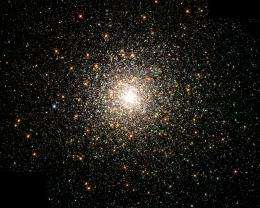Alien invaders pack the Milky Way

(PhysOrg.com) -- Around a quarter of the globular star clusters in our Milky Way are invaders from other galaxies, new research from Swinburne University of Technology (Australia) shows.
In a paper accepted for publication in the Monthly Notices of the Royal Astronomical Society, Swinburne astronomer Professor Duncan Forbes has shown that many of our galaxy’s globular star clusters are actually foreigners - having been born elsewhere and then migrating to our Milky Way.
“It turns out that many of the stars and star clusters we see when we look into the night sky are not natives, but aliens from other galaxies,” said Forbes. “They have made their way into our galaxy over the last few billion years.”
Previously astronomers had suspected that some star clusters, which contain around a million stars each, were foreign to our galaxy, but it was difficult to positively identify which ones.
Using Hubble Space Telescope data, Forbes, along with his Canadian colleague Professor Terry Bridges, examined old star clusters within the Milky Way galaxy.
They then compiled the largest ever high-quality database to record the age and chemical properties of each of these clusters.
“Using this database we were able to identify key signatures in many of the star clusters that gave us tell-tale clues as to their external origin,” Forbes said.
“We determined that these foreign-born globular star clusters actually make up about one quarter of our Milky Way globular star cluster system. That implies tens of millions of accreted stars - those that have joined and grown our galaxy - from globular star clusters alone.”
The researchers’ work also suggests that the Milky Way may have swallowed-up more dwarf galaxies than was previously thought.
“We found that many of the foreign clusters originally existed within dwarf galaxies - that is ‘mini’ galaxies of up to 100 million stars that sit within our larger Milky Way.
“Our work shows that there are more of these accreted dwarf galaxies in our Milky Way than was thought. Astronomers had been able to confirm the existence of two accreted dwarf galaxies in our Milky Way - but our research suggests that there might be as many as six yet to be discovered.
"Although the dwarf galaxies are broken-up and their stars assimilated into the Milky Way, the globular star clusters of the dwarf galaxy remain intact and survive the accretion process."
“This will have to be explored further, but it is a very exciting prospect that will help us to better understand the history of our own galaxy.”
Forbes’ research was carried out in Canada as part of an Australian Research Council International Fellowship.
More information: Accreted versus in situ Milky Way globular clusters, Monthly Notices of the Royal Astronomical Society, Available at arxiv.org/abs/1001.4289
Provided by Swinburne University of Technology


















